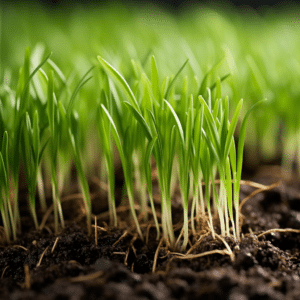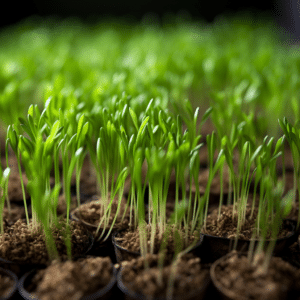Wheatgrass is a nutrient-rich superfood that has gained popularity for its numerous health benefits. Whether you’re looking to incorporate wheatgrass into your daily diet or want to learn more about this incredible plant, this comprehensive guide will provide you with everything you need to know about growing and caring for wheatgrass. From understanding the basics and preparing to plant, to the planting process and harvesting, we’ve got you covered every step of the way.
Understanding the Basics of Wheatgrass

Before diving into the world of wheatgrass cultivation, it’s important to familiarize yourself with the basics. Wheatgrass is a young grass that is derived from the common wheat plant, scientifically known as Triticum aestivum. Packed with essential vitamins, minerals, and antioxidants, consuming wheatgrass has been linked to improved digestion, boosted immune function, and increased energy levels.
Wheatgrass is not only a popular health trend but also a nutritional powerhouse. It is loaded with vitamins A, C, E, and K, as well as iron, magnesium, and calcium. This combination of nutrients makes wheatgrass an excellent source of antioxidants, which help protect the body against harmful free radicals. Additionally, wheatgrass is rich in chlorophyll, a pigment that aids in detoxification and supports overall health.
While wheatgrass may seem like a trendy health food, its use dates back thousands of years. Ancient civilizations, such as the Egyptians and Mesopotamians, recognized the healing properties of wheatgrass and used it in traditional medicine. They believed that wheatgrass could cleanse the body, promote vitality, and even cure certain ailments. Today, wheatgrass is widely cultivated and has become a staple ingredient in juicing and natural health practices.
When it comes to cultivating wheatgrass, there are a few key factors to consider. First, you’ll need to choose the right variety of wheatgrass seeds. There are different types available, each with its own unique characteristics and flavor profiles. Some popular varieties include Hard Red Winter Wheat, Soft Red Winter Wheat, and Hard White Winter Wheat.
Once you have selected your wheatgrass seeds, it’s time to prepare the growing medium. Wheatgrass can be grown in soil or using hydroponic methods. If you choose to grow it in soil, make sure to use a high-quality organic potting mix. Hydroponic systems, on the other hand, allow you to grow wheatgrass without soil, using nutrient-rich water instead.
After preparing the growing medium, it’s time to sow the seeds. Spread a layer of seeds evenly over the soil or place them in the designated slots of your hydroponic system. Make sure to water the seeds gently and keep them moist throughout the germination process. Within a few days, you’ll start to see tiny sprouts emerging from the soil or hydroponic system.
As the wheatgrass grows, it’s important to provide it with adequate sunlight or artificial light. Place the trays or containers in a well-lit area, ensuring that the wheatgrass receives at least 6-8 hours of light per day. If using artificial light, choose a full spectrum grow light that mimics natural sunlight.
Harvesting wheatgrass is a simple process. Once the grass reaches a height of around 6-8 inches, it’s ready to be harvested. Use a sharp pair of scissors or a wheatgrass juicer to cut the grass just above the soil level. You can then use the harvested wheatgrass in various ways, such as juicing, adding it to smoothies, or incorporating it into salads and other dishes.
In conclusion, wheatgrass is a versatile and nutrient-dense superfood that has been valued for its health benefits for centuries. Whether you’re interested in cultivating your own wheatgrass or simply incorporating it into your diet, understanding the basics of wheatgrass will help you make the most of this incredible plant.
Preparing to Plant Your Wheatgrass

Before you can enjoy the benefits of fresh wheatgrass, proper preparation is essential. Here’s what you need to do:
Choosing the Right Wheatgrass Seeds
Quality seeds are the foundation of a successful wheatgrass crop. Opt for organic, untreated wheatgrass seeds that are specifically labeled for sprouting or juicing. Make sure the seeds are fresh and have a high germination rate. It is advisable to buy seeds from reputable suppliers or health food stores to ensure their quality.
Gathering Essential Growing Supplies
In addition to quality seeds, you will need a few essential supplies to grow wheatgrass successfully. These include a shallow tray or container, nutrient-rich soil or a growing medium, a spray bottle for watering, and a source of natural light or a grow light for indoor cultivation. Ensure that the tray you choose has drainage holes to prevent excess moisture buildup.
The Planting Process
Now that you have everything you need, it’s time to start planting your wheatgrass. Follow these step-by-step instructions to ensure a healthy and thriving crop:
Step-by-Step Guide to Planting Wheatgrass
- Prepare the growing medium by moistening it with water until it is damp but not soggy.
- Spread the medium evenly in the tray, filling it about halfway.
- Evenly scatter the wheatgrass seeds over the damp medium, ensuring they are not overcrowded.
- Add another thin layer of the growing medium, just enough to cover the seeds.
- Use the spray bottle to gently water the seeds, ensuring the entire surface is moist.
- Place the tray in a location with indirect sunlight or under the grow light.
- Keep the seeds consistently moist by misting them with water daily.
- After about one week, you will start to see the wheatgrass shoots emerging.
Common Mistakes to Avoid When Planting
While growing wheatgrass is relatively straightforward, there are a few common mistakes to avoid to ensure optimal success:
- Avoid overwatering, as it can lead to mold or fungus growth. Stick to misting the seeds regularly.
- Don’t expose the wheatgrass to direct sunlight, as it can scorch and damage the delicate shoots.
- Do not overcrowd the seeds in the tray, as this can prevent proper air circulation and hinder growth.
- Make sure the growing medium is adequately drained to prevent waterlogging, which can lead to root rot.
Caring for Your Wheatgrass
As your wheatgrass continues to grow, proper care is crucial to ensure healthy development and vibrant green shoots.
Watering and Light Requirements
Wheatgrass thrives in moderate light conditions. If growing indoors, ensure that the wheatgrass receives around 6-8 hours of indirect sunlight or use a grow light for approximately the same duration. Water the wheatgrass by misting it daily, making sure the growing medium remains consistently moist but not waterlogged.
Dealing with Common Wheatgrass Pests and Diseases
While wheatgrass is generally resistant to pests and diseases, occasional issues may arise. Common pests include aphids and spider mites, which can be managed using natural insecticides or by introducing beneficial predatory insects. To prevent diseases, maintain proper air circulation and avoid overwatering.
Harvesting and Using Your Wheatgrass

Once your wheatgrass has reached the desired height of around 6-8 inches, it’s time to harvest and enjoy the fruits (or rather, shoots) of your labor.
When and How to Harvest Wheatgrass
The ideal time to harvest wheatgrass is when the shoots have reached their peak nutritional value. Using clean scissors or a sharp knife, cut the wheatgrass just above the soil level. Harvest only what you need and consume it immediately to maximize its nutritional benefits.
Storing and Preserving Wheatgrass
Freshly harvested wheatgrass can be stored in airtight containers in the refrigerator for up to a week. To prolong its freshness, consider freezing the wheatgrass in ice cube trays for convenient use in smoothies or juices. Alternatively, you can also juice the wheatgrass and freeze it in ice cube trays for a quick and easy boost of nutrition whenever you need it.
Now that you’re equipped with the knowledge of growing and caring for wheatgrass, you can embark on your journey to a healthier lifestyle. With a little time and effort, you’ll be enjoying the numerous benefits of this vibrant and nutrient-packed superfood. Embrace the world of wheatgrass and let it nourish your body, mind, and soul.